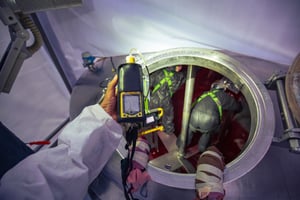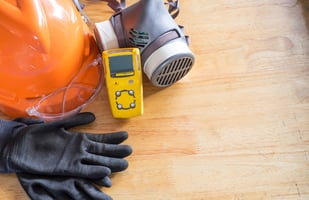Confined spaces present unique risks and hazards that require specific regulations to ensure the...
What are the Legal Requirements for Gas Testing Prior to Hot Work?
Performing hot work activities in an environment where flammable gases are present can pose significant risks. To mitigate these hazards and ensure the safety of workers, various legal requirements must be followed, including gas testing prior to initiating hot work. In this post, we will explore the essential legal aspects surrounding gas testing and its significance in the workplace. Specifically, we will discuss permits, the Health and Safety at Work Act (HASAWA), risk assessment, and DSEAR zoning.

Permits: A Necessity for Hot Work
Before conducting any hot work activities, it is essential to obtain the necessary permits. These permits, often referred to as hot work permits or work authorisation permits, serve as formal authorisation to carry out potentially hazardous tasks. They are typically issued by the organisation or authority responsible for safety within the workplace.
Hot work permits play a crucial role in the prevention of accidents. They ensure that appropriate safety measures, including gas testing, are undertaken before any hot work begins. The permits also outline specific precautions and conditions that must be met during the hot work process, including the use of personal protective equipment (PPE), fire prevention measures, and adherence to safety protocols.
HASAWA: The Foundation for Workplace Safety
The Health and Safety at Work Act (HASAWA) is a fundamental piece of legislation in the United Kingdom that imposes legal obligations on employers and employees to ensure health and safety in the workplace. Under HASAWA, employers have a duty to protect the health, safety, and welfare of their employees, as well as others who may be affected by their work activities.
Regarding hot work and gas testing, HASAWA requires employers to conduct suitable risk assessments and take necessary precautions to prevent accidents and occupational hazards. This includes assessing the presence of flammable gases in the work area and implementing appropriate control measures, such as gas testing, to mitigate the associated risks.
Risk Assessment: Identifying Hazards and Mitigation Strategies
Risk assessment is a vital step in ensuring workplace safety. Before initiating hot work, a thorough risk assessment must be conducted to identify potential hazards and assess their likelihood and severity. This assessment should specifically include the identification of flammable gases present in the work area.
Gas testing, such as atmosphere monitoring or gas concentration measurement, is an essential component of the risk assessment process. It helps determine the presence and levels of flammable gases and ensures that adequate control measures are in place. The results of gas testing inform decision-making regarding the suitability of conducting hot work, the selection of appropriate PPE, and the implementation of control measures to minimize the risk of ignition or explosion.
DSEAR Zoning: Classifying Hazardous Areas
In the United Kingdom, the Dangerous Substances and Explosive Atmospheres Regulations 2002 (DSEAR) provide a framework for managing the risks associated with dangerous substances, including flammable gases, in the workplace. DSEAR requires employers to classify areas where explosive atmospheres may occur and implement appropriate control measures accordingly.
DSEAR zoning is the process of dividing the workplace into zones based on the likelihood and duration of the presence of flammable gases or vapours. Zoning enables employers to allocate specific control measures, including gas testing, based on the level of risk associated with each zone. For example, Zone 0 is an area where an explosive atmosphere is continuously present, whereas Zone 2 is an area where an explosive atmosphere is unlikely to occur or only for a short duration.
Conclusion
When it comes to hot work activities in the presence of flammable gases, complying with legal requirements is essential to safeguard workers' health and safety. Gas testing plays a crucial role in this process, helping identify and assess the risks associated with flammable gases. By obtaining the necessary permits, adhering to the Health and Safety at Work Act (HASAWA), conducting thorough risk assessments, and implementing DSEAR zoning, employers can ensure a safe working environment and prevent potential accidents or hazardous incidents.
Remember, prioritising safety not only protects employees but also contributes to a productive and responsible work culture, fostering the well-being of all individuals involved in the workplace environment.







